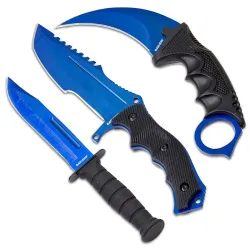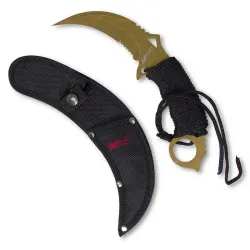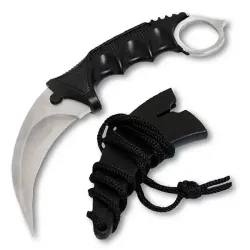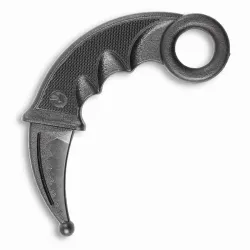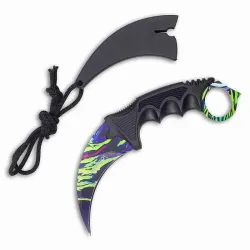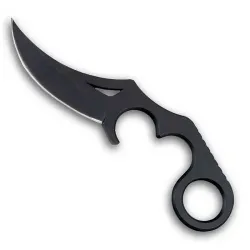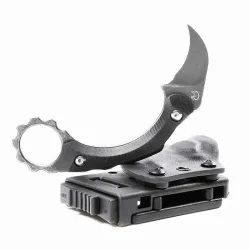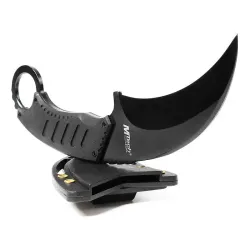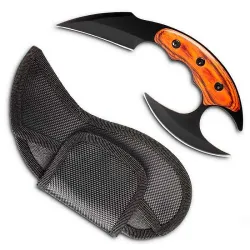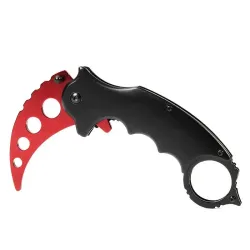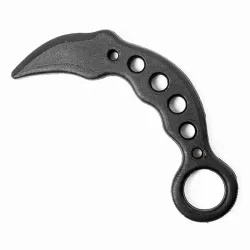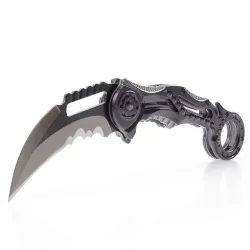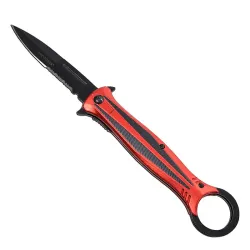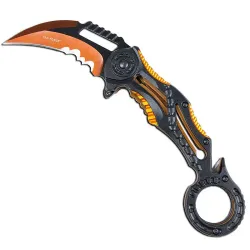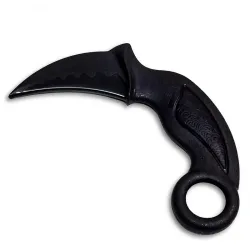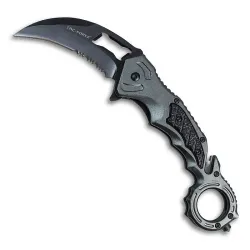Karambit Knives
-
$11.95
-
$11.95
-
$11.95
-
$32.95
-
$22.95
-
$21.95
-
$20.95
-
$18.95
-
$19.95
-
$11.95
-
$24.95
-
$29.95
-
$32.95
-
$32.95
-
$34.95
-
$15.95
-
$18.95
-
$18.95
-
$26.95
-
$34.95
-
$29.95
-
$15.95
-
$22.95
-
$18.95
-
$21.95
-
$18.95
-
$32.95
-
$19.95
-
$19.95
-
$18.95
-
$19.95
-
$34.95
-
$32.95
-
$16.95
-
$16.95
Today, karambit knives are used by martial artists, collectors, and self-defense enthusiasts who value both performance and craftsmanship. Whether you prefer a fixed-blade design for strength or a folding karambit for portability, each type offers its own advantages. Fixed karambits tend to be the most durable and are favored by professionals for field or combat use. Folding karambits, on the other hand, fit easily in a pocket and are ideal for everyday carry. For training and technique development, practice karambits made from safe materials let you master the same movements without the risk of injury.
One of the most appealing aspects of a karambit knife is its versatility. While it's often associated with tactical applications, the design also makes it an excellent utility tool for outdoor use and cutting tasks that demand control and finesse. The curved blade can slice cleanly through rope, fabric, and other materials, and the ergonomic handle design helps maintain comfort during repetitive motion. Many modern karambits also feature quick-deploy mechanisms, reinforced grips, and high-grade steel blades that perform as well in everyday use as they do in martial arts training.
Types of Karambit Knives
There are several styles of karambit knives to choose from, each designed for a specific purpose. Fixed-blade karambits are built for strength and dependability, making them popular among tactical users and martial artists who value stability. Folding karambits are compact and easy to carry, offering quick deployment and versatility for everyday use. Training karambits are made from blunt materials like rubber or polypropylene, allowing you to practice safely without the risk of cuts. Collectors often gravitate toward custom or decorative karambits that feature detailed designs, exotic handle materials, and polished finishes that highlight the beauty of the curved blade.
How to Use a Karambit Knife Safely
Because of its unique curve and finger ring, a karambit requires a different grip technique than a standard knife. The most common is the reverse grip, where the blade extends from the bottom of your fist and the ring sits around your index finger or pinky for added control. This grip provides power and precision for slashing and hooking motions. It is important to practice slowly at first, especially if you are new to the design, to avoid injury. For those learning martial arts styles that incorporate karambit techniques, training karambits are the best way to develop skill and confidence safely.
History and Origins of the Karambit
The karambit traces its roots to Indonesia, where it began as an agricultural tool used for cutting crops and clearing vegetation. Its curved shape was modeled after animal claws for natural efficiency, and it eventually evolved into a defensive weapon used in traditional Silat martial arts. As the design spread through Southeast Asia, it gained a reputation for its effectiveness in close combat. Modern karambits continue that tradition while incorporating modern materials such as stainless steel, carbon fiber, and reinforced polymer. The combination of cultural heritage and modern engineering has made the karambit a symbol of both functionality and craftsmanship.
Why Choose a Karambit Knife
A well-made karambit offers a perfect balance of practicality and artistry. The design provides incredible control, especially in confined spaces where precision is critical. Whether you need a knife for martial arts training, outdoor survival, or personal protection, a karambit delivers reliable performance and unmistakable style. Each blade reflects centuries of evolution and innovation, making it one of the most distinctive knives you can own. Browse our selection of karambit knives to find the one that matches your needs and experience level.
What Is a Karambit Knife Used For?
A karambit knife is used for close control cutting, tactical defense, and specialized utility tasks. Its curved blade and ring grip let you make precise slashing and hooking motions while keeping the knife secure in the hand.
The karambit started as an agricultural tool in Southeast Asia and evolved into a compact tool and defensive implement. In practice, people use karambits for several distinct purposes. In martial arts and self-defense, the curved blade and ring allow fast, controlled slashes, trapping moves, and retention grips that reduce the chance of the knife being taken away. For tactical users the design makes it easy to maintain control in tight or dynamic situations where precision matters.
Outside of defense, karambits serve as useful utility knives for cutting rope, webbing, and other fibrous materials because the curved edge slices smoothly with a pulling motion. Collectors prize karambits for their unique shape, historical roots, and the variety of handle and blade materials available. Trainers and hobbyists use blunt practice karambits to learn handling and transitions without risk of injury.
If you plan to use a karambit for a specific purpose, pick the style that matches that use. Fixed karambits are strongest for heavy duty or professional use. Folding karambits are easier to carry and conceal. Training karambits let you build skill safely. Always practice proper handling and check local laws before carrying a karambit for defense.
What's the Difference Between a Fixed Karambit and a Folding Karambit?
Fixed karambits are one-piece blades built for strength and reliability, while folding karambits fold into the handle for safer and easier carry. Each style has its own advantages depending on how you plan to use it.
Fixed karambits are made as a single, solid piece or with a permanently mounted blade. That construction gives them maximum strength and rigidity, which makes them better suited for heavy-duty tasks and professional use where durability matters. Fixed karambits usually require a sheath for safe carry and deploy instantly when drawn. If you plan to use the blade for demanding cutting, hard use, or tactical work, a fixed karambit is the safer, more dependable choice.
Folding karambits collapse into the handle and typically use a locking mechanism to keep the blade secure when open. Their main advantages are portability and discretion. A folding karambit can be clipped to a pocket, carried in a bag, or concealed more easily than a fixed blade. Modern folding designs often include frame locks, liner locks, or axis-style locks along with a pocket clip and a flipper or thumb stud for quick deployment. For everyday carry and convenience, a well-made folding karambit is often the better option.
There are trade-offs to consider. Folding karambits add moving parts that can wear out or fail if not maintained, and even the best locks are usually not as strong as a fixed blade. Fixed karambits sacrifice carry comfort and concealability because they need a sheath and take up more space. Think about how you will use the knife, how you will carry it, and what local laws require before choosing.
Finally, if training is part of your plan, look for training versions of either style. Blunt or polypropylene training karambits mimic the weight and handling without a sharp edge, letting you learn transitions and grips safely whether you choose fixed or folding in your real setup.
Are Karambit Knives Good for Everyday Carry?
Karambit knives can be good for everyday carry for some people, but they are not the best choice for everyone. Their curved blade and ring grip offer excellent control for cutting tasks and defensive retention, but that same shape can make routine tasks like opening boxes or food prep awkward compared with a straight-bladed EDC folder.
If you value compactness, retention, and a secure grip, a folding karambit with a reliable lock and a low-profile pocket clip can make a useful EDC tool. Folding karambits deploy quickly and tuck safely into a pocket, and the ring helps keep the knife from slipping during work. On the other hand, fixed karambits are bulkier and require a sheath, so they are rarely practical as daily carry unless your job or activity specifically calls for that design.
A few practical considerations will help you decide. First, think about the common tasks you need an EDC knife for. If you mostly cut cardboard, open packages, or do light utility work, a traditional folder with a straight edge may be faster and more comfortable. Second, check your local laws and workplace policies. Some places restrict or ban carry of certain blade shapes, locking mechanisms, or blade lengths, and employers often have rules about knives on site. Third, consider concealability and how you carry. A low-profile folding karambit with a reversible clip and secure lock is easier to carry discreetly than a fixed blade.
Finally, training and familiarity matter. Karambits handle differently than mainstream EDC knives, so practice with a training karambit before relying on one every day. If you choose a karambit for EDC, pick a well-built model with a dependable lock, quality steel, and a comfortable handle. That will give you the benefits of the design while minimizing the downsides.
How Do I Choose the Right Size Karambit Knife?
Choose a karambit size based on what you plan to do with it. For self-defense and close control work, shorter blades in the 1.5 to 3 inch range are common because they keep the overall profile compact and allow fast, controlled motions. For utility or outdoor cutting tasks, a slightly longer blade can help, but very long karambits are uncommon and harder to carry comfortably.
Think about overall length as well as blade length. A 3 inch blade on a karambit often results in a 6 to 8 inch overall length, so try to visualize how that will carry on your body or fit in a sheath or pocket. For folding karambits, check closed length and pocket clip placement so you know how it will ride in a pocket. For fixed karambits, consider sheath bulk and how you will carry it on a belt or pack.
Pay attention to ring diameter and handle ergonomics. The ring should fit your preferred finger without forcing your grip. Some people prefer the ring around the index finger for quicker transitions, others like the pinky placement for retention. If you can, test ring sizes in person or check manufacturers' measurements to make sure the fit feels natural for your hand size.
Also match size to training options. If you plan to practice moves, get a training karambit that matches the size and weight of the live blade so your muscle memory transfers accurately. Finally, account for legal and workplace limits. Blade length restrictions vary by jurisdiction and employer policy, so choose a size that keeps you compliant while still meeting your needs. If you want, tell me your typical hand size and primary use and I can recommend a specific size range.
Are Karambit Knives Legal to Carry?
There is no single federal rule that specifically bans karambits across the United States, but legality depends heavily on state and local laws. Many states treat karambits like other knives and regulate them by blade length, locking mechanism, or whether the knife is carried openly or concealed.
Some states are permissive about folding pocket knives while restricting fixed blades or certain locking mechanisms. Other states have broader prohibitions or vague language that can be interpreted by police or prosecutors, so a folding karambit with a secure lock may be fine in one place and still risky in another. If you live in or travel to a state with strict knife laws, even lawful possession can become a criminal issue if the knife is carried in a way the law does not allow.
There are also location-based federal restrictions to keep in mind. Federal buildings, courthouses, some parks, and military bases may ban knives entirely or apply their own rules, and airports follow Transportation Security Administration rules that prohibit knives in carry-on baggage. Always pack knives in checked luggage when flying.
Practical tips to reduce risk: choose a reputable folding karambit with a proven lock if you plan to carry, carry it in a way that complies with local concealed-carry rules, and keep documentation or receipts that show intent to use it as a tool when relevant. When in doubt, do not carry the knife and consult your state code or a local attorney for definitive guidance.
How Do You Hold a Karambit Knife Correctly?
There are two main ways to hold a karambit knife: the forward grip and the reverse grip. Both use the ring for control, but they serve different purposes. The forward grip has the blade extending upward from the top of the hand, which makes it more natural for utility cutting and general tasks. The reverse grip has the blade curving downward from the bottom of the hand, which is the traditional way to use a karambit for martial arts or self-defense.
In the forward grip, your index finger usually goes through the ring, and your thumb rests along the spine of the blade for control. This grip allows precise slicing motions for everyday cutting or outdoor use. In the reverse grip, your pinky finger goes through the ring, and the blade follows the curve of your hand for fast, hooking movements. This orientation works well for trapping, pulling, or defensive actions in close quarters.
Whichever grip you choose, the key is comfort and safety. Your hand should feel secure without straining your fingers. If you are new to karambits, start by practicing slowly with a training knife to get used to the motion of drawing, flipping, and rotating. Once you can maintain control through transitions without losing your grip, you can move on to live blades. Practicing the correct grip helps you take advantage of the karambit's design while staying safe and in control.
Is the Karambit Actually Used in Martial Arts?
Yes. The karambit has a long history in Southeast Asian martial arts, especially in Indonesian systems like Silat, where it was adapted from agricultural tools into a close-quarters weapon. Practitioners developed grips, draws, and sweeps that take advantage of the curved blade and ring for control, retention, and hooking techniques.
Modern martial arts and combatives that teach edged-weapon work sometimes include karambit-specific drills. Those drills focus on transitions, retention, trapping, and integrating the karambit into empty-hand techniques. Because the karambit behaves very differently from straight knives, effective training emphasizes body mechanics, angles of attack, and safe drawing and reholstering methods.
That said, the karambit is a specialized tool. Not every martial art uses it, and some instructors prefer straight blades or empty-hand options for general self-defense. If you want to learn karambit techniques, look for instructors with credible experience and use training karambits to develop skill before handling sharp blades. Proper instruction will teach safe practice, legal considerations, and realistic applications that transfer to practical use.
What Is the Reverse Grip on a Karambit?
The reverse grip is the traditional karambit hold where the blade curves down and extends from the bottom of your fist, with the ring seated around a finger for retention. In this orientation the cutting edge faces away from your forearm and the tip points toward the ground when your arm is relaxed. The reverse grip favors hooking, slashing, and close-quarters control rather than long, open cuts.
Common finger placements are the pinky or index finger in the ring depending on the technique and personal comfort. Pinky placement maximizes retention and makes quick hooking motions easier. Index placement gives faster transitions for some people and can feel more natural for forward-grip tasks. Try both on a training karambit to see which fits your hand and training style.
Advantages of the reverse grip include better retention in grappling or dynamic situations, stronger hooking motions for control or disarming, and a natural alignment for close-quarters defensive moves. The grip also keeps the blade close to the body for compact defensive use.
Practice slow and controlled transitions with a blunt training karambit until your muscle memory is solid. When you train, focus on smooth draws, secure ring placement, and safe reholstering. The reverse grip is powerful but requires familiarity to avoid accidental slips during transitions.
Are There Training Karambits for Beginners?
Yes. Training karambits are made specifically for learning handling, transitions, and grip work without the risk of a sharp edge. They come in several forms, including blunt metal practice blades, rubber or polymer trainers, and lightweight plastic models that match the shape and ring placement of a real karambit.
A good training karambit should mirror the size, weight, and balance of the live blade as closely as possible so your muscle memory transfers accurately. If the trainer is much lighter or has a different ring size, techniques will feel different when you switch to a sharp karambit. Many trainers also include rounded tips and smoothed edges to reduce the chance of accidental cuts during drills.
Start slowly with basic draws, grip changes, and controlled slashes. Practice reholstering and transitions between forward and reverse grips until the motions feel natural. Partner drills with proper safety gear are useful if your curriculum includes retention or disarming practice. As you gain confidence, progress to faster repetitions while maintaining correct form and control.
If you plan to train with a class or instructor, ask what type of trainer they recommend. Some schools prefer heavier, metal trainers to simulate real weight, while others use softer polymer trainers that are safer for partner work. Always prioritize safety, use eye protection when needed, and only move to sharp blades after you and your instructor agree that your technique and control are reliable.
Why Does a Karambit Have a Ring on the Handle?
The ring on a karambit gives you extra control and retention. With a finger through the ring the knife stays locked to your hand during fast transitions, grappling, or dynamic movement, which reduces the chance of it slipping or being taken away.
The ring also makes certain maneuvers and transitions possible. It lets you rotate the knife quickly between forward and reverse grips, spin the blade for quick draws, and perform retention-oriented techniques where the blade remains under your control while you use your free hand. For many users the ring improves precision because it fixes the blade relative to the fingers and wrist.
Different ring sizes and placements change how the karambit feels. A larger ring gives room for index finger placement and faster transitions, while a smaller ring favors pinky placement and maximum retention. Some modern designs add textured rings, relief cuts, or secondary thumb rests to improve ergonomics and speed.
If you are new to karambits, practice ring placement and transitions slowly with a trainer. That builds muscle memory so you can use the ring for control without fumbling. The ring is one of the signature features of the karambit and, when used properly, it turns the knife into a highly controlled tool rather than just another blade.
What Is the Curved Blade on a Karambit For?
The curved blade on a karambit is designed to enhance slicing power, control, and retention. The inward curve concentrates force along a smaller contact area during a pulling cut, so the blade bites deeper with less effort than a straight edge doing the same motion. That geometry makes the karambit especially effective for tasks that use a drawing or hooking motion rather than a straight push cut.
In practical terms the curve helps in close quarters where long slashes are not possible. It lets you control the cut by pulling the blade toward you, using wrist rotation and small, precise movements rather than large arm swings. That same characteristic is why martial artists favor the design for trapping, hooking, and cutting along contours rather than chopping across flat surfaces.
The curve also improves retention and edge preservation for certain tasks. When you slice with the belly of the blade the motion keeps more of the cutting surface engaged and reduces accidental tip-first impacts. For utility work the curved edge excels at cutting rope, straps, and webbing because the material naturally conforms to the arc of the blade during a draw cut.
There are trade offs. The karambit is not well suited to push cuts, batoning, or tasks that require a long straight edge. The tip geometry varies by design so some karambits are better at piercing while others prioritize a rounded belly for clean slicing. Match the blade profile to your intended use and consider a training session or hands-on inspection to feel how the curve changes handling and cutting behavior.
Can a Karambit Have a Trailing Point Blade?
Yes. A karambit can be fitted with a trailing point blade profile, though it is less common than the classic hawkbill shape. A trailing point blade has a back edge that sweeps upward toward the tip, which moves the point higher and creates a longer cutting belly. When combined with a karambit handle and ring, that profile increases slicing area and can improve skinning and draw-cut performance.
There are trade-offs to consider. A trailing point tip sits higher and is often thinner, which makes it excellent for fine slicing, skinning, and tasks that need a large, curved cutting surface. At the same time the tip becomes more exposed and potentially more fragile than a rounded or reinforced hawkbill tip, so a trailing point karambit may be less suited to heavy piercing or hard-use tasks where tip strength matters.
Functionally a trailing point karambit blends the advantages of the curved karambit belly with a sharper, more pronounced tip. That can be useful if your primary needs are utility cutting, detailed work, or tasks that benefit from a longer, continuous edge. For martial arts and close-quarter tactical work some users prefer the traditional inward curve because it favors hooking and retention. Others like the hybrid feel of a trailing point for versatile cutting and light piercing.
If you are considering a trailing point karambit, think about intended use and materials. Choose a blade steel and tip geometry that match your tasks, and if you plan to train, use a trainer that matches the blade profile so your transitions and control translate to the live knife. For heavy-duty or defensive roles, a more robust hawkbill profile will generally be stronger and more retention friendly. For detailed slicing and utility work, a trailing point karambit can be a very effective choice.
How Do You Sharpen a Karambit Knife?
Sharpening a karambit follows the same basic principles as sharpening any blade, but the curved profile means you need tools and strokes that match the arc of the edge. Use a small, tapered or narrow stone or rod so you can follow the belly of the blade instead of trying to force the whole curve on a flat stone.
Start by choosing the right tools. A set of water or oil stones that includes a finer progression is useful for re-profiling and finishing. For the tight curve, ceramic rods, tapered diamond rods, or leather strops wrapped with compound work best because they conform to the arc. If the blade has serrations, use a conical or tapered diamond rod sized to the serration gullets.
Use these steps as a safe, reliable method:
- Clean the blade and inspect the edge for nicks or a rolled bevel.
- If you need to remove chips or re-profile, start with a coarse stone and keep your stroke aligned with the curve, drawing the edge across the stone as if you were making a pulling cut. Work a small section at a time so you maintain a consistent angle.
- Move to a medium grit to refine the bevel. Again follow the arc and keep strokes consistent. Count strokes per section to avoid overworking one area.
- Finish on a fine stone or ceramic rod, using light pressure and smooth, controlled passes that follow the belly of the blade. For a razor edge, finish with a leather strop and polishing compound, drawing the edge away from the cutting surface to remove the burr.
- For serrated edges, sharpen each serration individually with a tapered rod, then lightly strop the flats to remove burrs. Do not try to sharpen serrations with a flat stone.
Maintain a consistent edge angle that suits the steel and intended use. Many karambits sharpen well at roughly 18 to 22 degrees per side, but harder steels and tactical blades can take a slightly lower angle while utility-focused blades may benefit from a slightly more obtuse angle for tip strength. If you are unsure, follow the factory bevel or start conservative and test before thinning the edge further.
Use care and protect your fingers. The ring and curved shape can make handling awkward while sharpening, so clamp the blade in a vise with protective jaws or use a guided sharpening jig when possible. If the curve or tip is very aggressive, consider a professional sharpening service that has the right rods and experience with complex profiles. Regular light honing and stropping will keep the edge performing between full sharpenings and reduce how often you need to remove steel.
Are Karambit Knives Effective for Self-Defense?
Yes, karambit knives can be effective for self-defense when used by someone who is trained and understands the design. The curved blade, ring grip, and retention-friendly geometry make the karambit well suited to close-quarters control, quick slashes, and retention maneuvers that reduce the chance of the knife being taken away.
That said, effectiveness depends heavily on skill and context. A karambit in an untrained hand can be awkward and even dangerous to the carrier. Training builds the muscle memory for safe draws, transitions between forward and reverse grips, and retention techniques that matter most in a real confrontation. Without that training, the advantages of the design are much harder to realize.
Consider practical trade-offs. Karambits excel in very close ranges and in situations where retention and control are priorities. They are less useful for long reach or utility cutting compared with straight-bladed knives. In a self-defense scenario you also need to factor in legal risk, opportunity to escape, and safer alternatives like de-escalation, awareness, and nonlethal tools. A knife is a last-resort option and should be carried and used only where it is legal and you are prepared to accept the consequences.
If you plan to rely on a karambit for defense, train with certified instructors, practice regularly with trainers and live blades when appropriate, and choose a model that fits your hand and carry habits. Proper training, realistic practice, and knowledge of the law are what make a karambit an effective tool rather than a liability.
Can a Karambit Be Used for Utility or Survival Tasks?
Yes. While the karambit is best known for close-quarters work and retention, its curved blade makes it surprisingly useful for a number of utility and survival tasks. The belly of the blade excels at draw cuts, which makes slicing rope, cordage, webbing, and straps faster and more controlled than with some straight blades. That pulling motion is also handy for field chores like cutting paracord, trimming cordage, or opening tightly bound bundles.
For small game processing and skinning, the curved edge can follow contours well and give clean, controlled cuts. A trailing point or longer-bellied karambit increases usable cutting length for those tasks. The ring and ergonomic handle help maintain control when working in awkward positions or when you need to keep a secure grip with wet or gloved hands.
There are limits to keep in mind. The karambit is not ideal for batoning, heavy chopping, or prying, and the curved profile reduces effectiveness for push cuts and some bushcraft tasks that favor a straight, robust edge. The tip on many karambits is more delicate than a drop-point or spear point, so avoid using it for forced piercing or prying that risks breaking the tip.
If you want a karambit that works well in the field, choose one with a thicker spine, a sturdy tip geometry, and full-tang construction if possible. Consider pairing it with a small straight-blade companion for chopping or batoning tasks. For everyday outdoor use pick a karambit with corrosion-resistant steel and a sheath that secures the blade safely for hiking or backpacking. With the right expectations and complementary tools, a karambit can be a very effective part of a survival or utility kit.
What Are the Advantages of a Karambit in Close Combat?
A karambit offers several clear advantages in close-quarters situations. Its curved blade and ringed handle make retention and control the design's biggest strengths. The ring secures the knife to your hand during dynamic movement or grappling, which lowers the risk of losing the blade in a struggle. The curve of the blade favors hooking and drawing cuts that are highly effective at short range where long reach is not possible.
Because the karambit is designed for pulling and slicing motions, it transfers cutting power efficiently with small wrist movements rather than large arm swings. That lets you deliver deep, effective cuts in confined spaces while maintaining balance and posture. The inward curve also helps protect the tip from accidental hard impacts, and the blade's belly gives you a continuous cutting surface for controlled, repeatable strikes.
Another advantage is the speed of transitions between grips and draws. Once you are trained, the karambit allows very fast deployment and smooth changes between forward and reverse grips. That flexibility is useful in mixed unarmed and edged-weapon situations where you need to switch quickly between defensive and offensive actions while preserving retention.
Finally, karambits are compact and easy to conceal compared with many fixed blades, so they are practical for close protection roles where a discreet tool is preferred. The trade-offs are reach and versatility for heavy-duty tasks, so the karambit excels specifically in tight, retention-focused encounters where control and quick, precise cuts matter most.





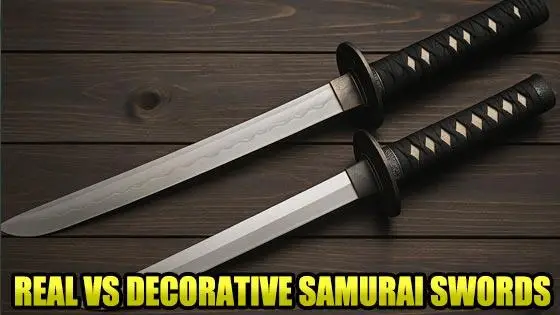
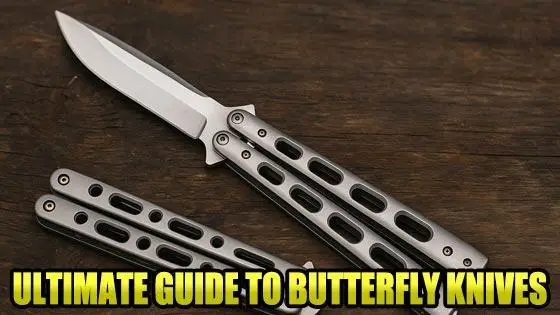
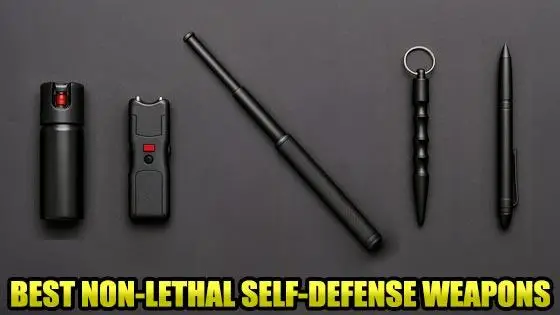
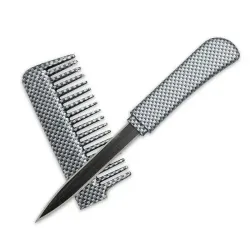
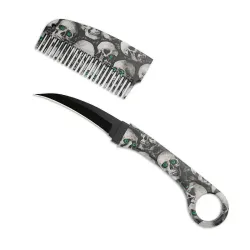
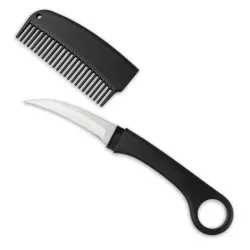

 (1)
(1)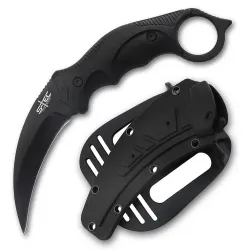
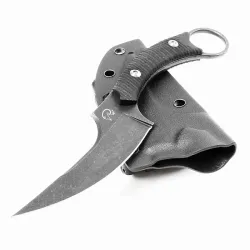
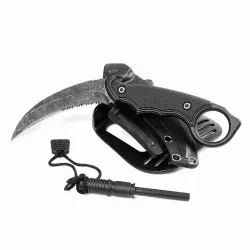
 (1)
(1)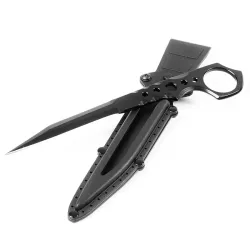
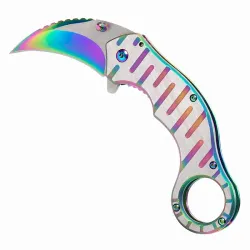
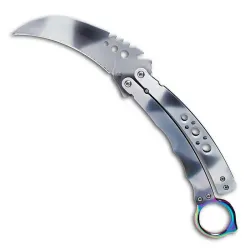

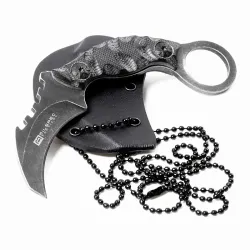
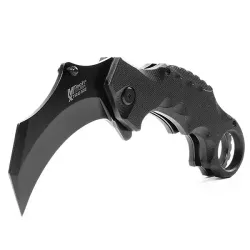
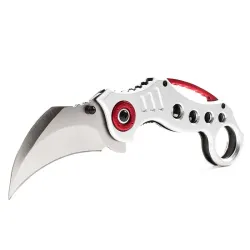
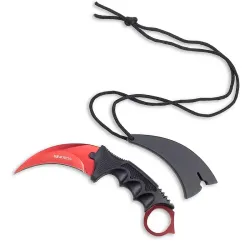
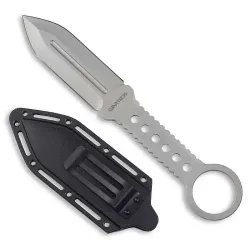
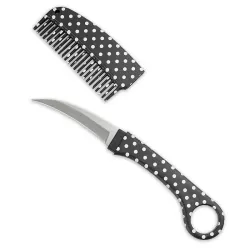

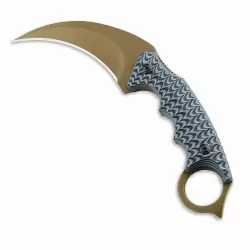
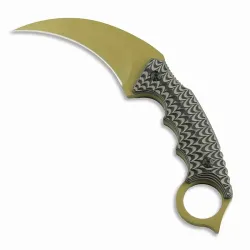
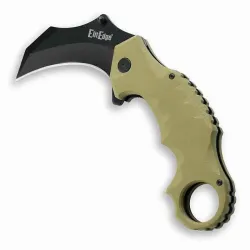
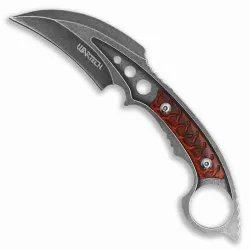
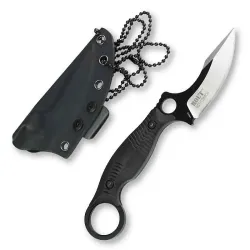
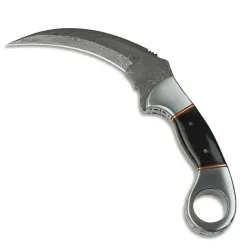

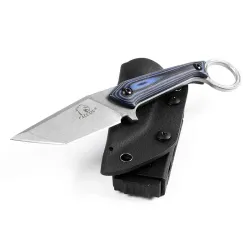
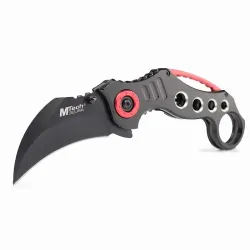
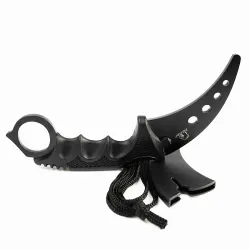
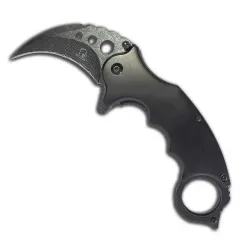
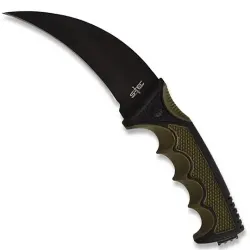
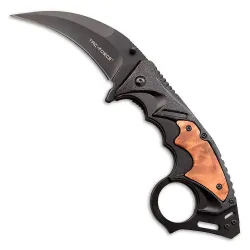
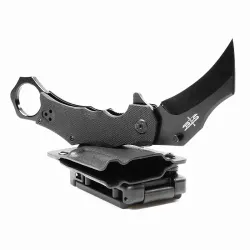
 (4)
(4)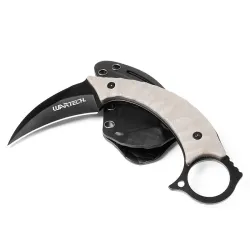
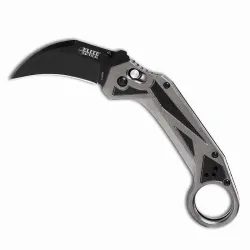
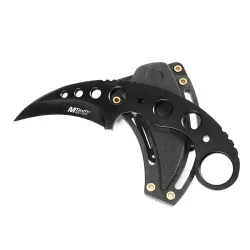
 (1)
(1)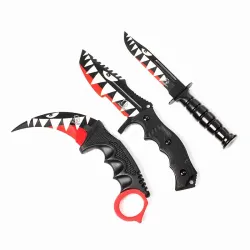
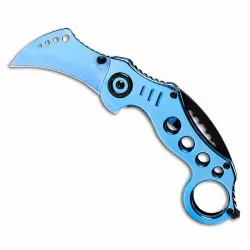
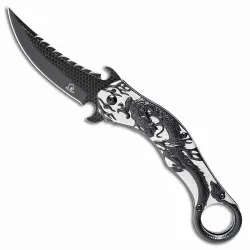
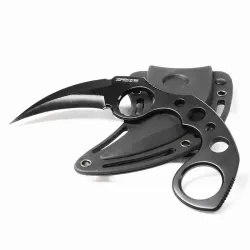
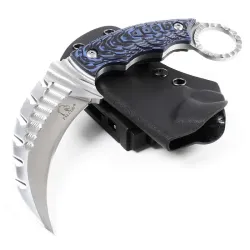
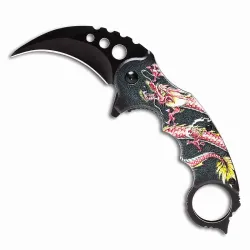
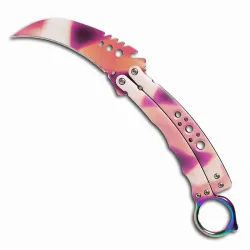

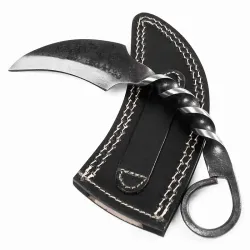
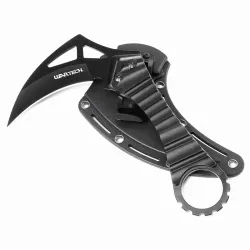
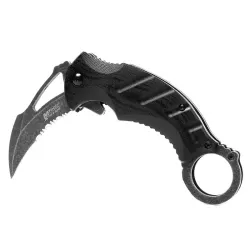
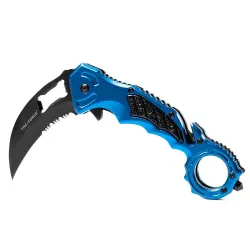
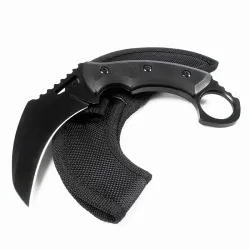
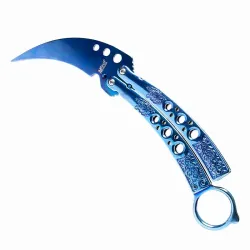

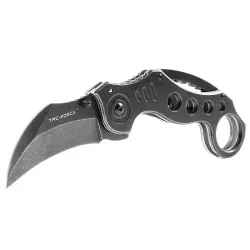
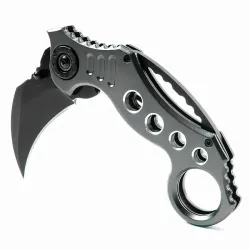
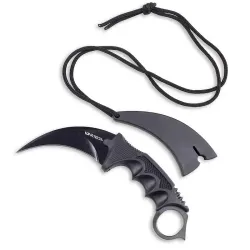

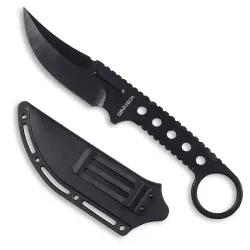
 (1)
(1)
